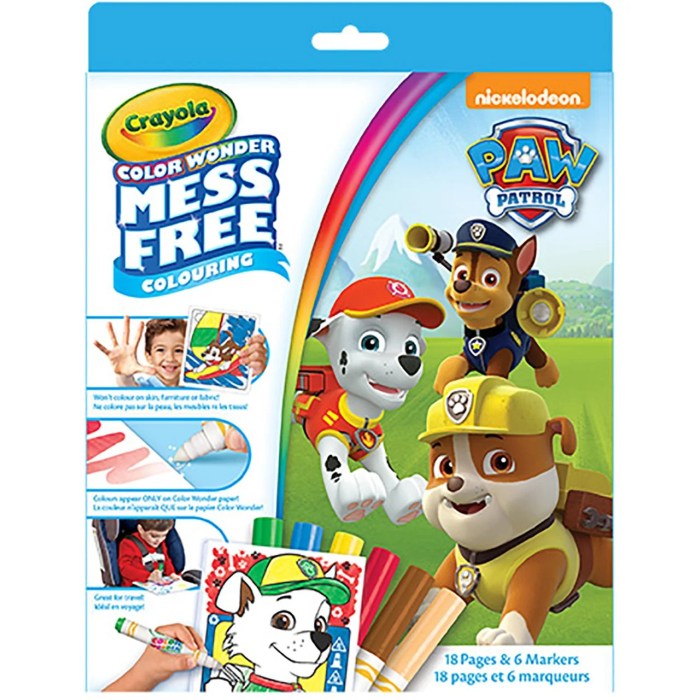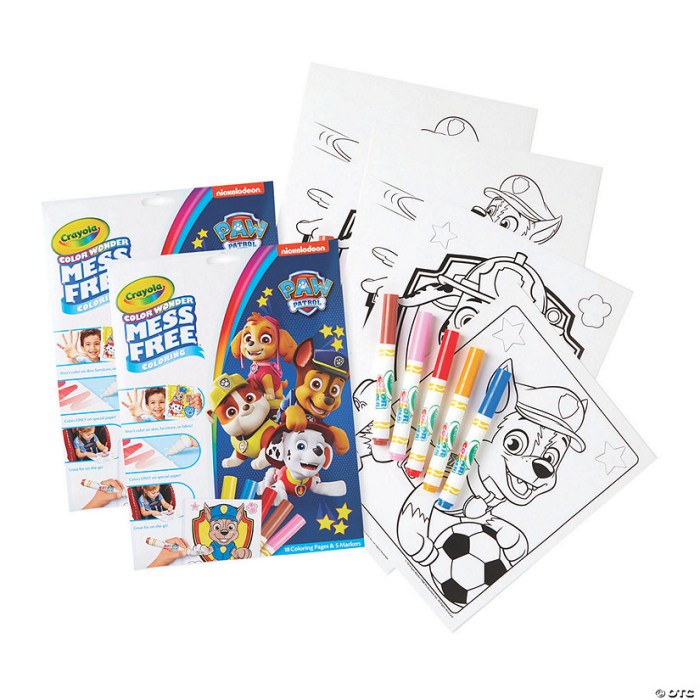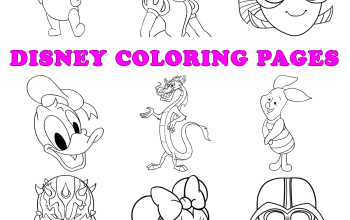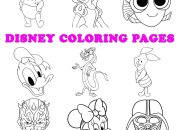Defining “Mess-Free” Coloring Books

Mess free coloring book – Mess-free coloring books represent a significant advancement in children’s activity books, addressing the common frustration of messy crayons, markers, and paints. These books utilize innovative technologies and materials to allow for creative expression without the usual accompanying spills and smudges. The core principle is to contain the coloring medium within the designated areas of the page, offering a cleaner and more enjoyable coloring experience.The various methods employed to achieve this mess-free experience differ considerably in their approach and effectiveness.
Mess-Free Coloring Book Technologies and Materials
Several technologies contribute to the mess-free nature of these coloring books. Water-activated coloring books, for instance, use special paper that reveals color only when wet. The coloring medium, typically a water-based pen or brush, interacts with the paper to create vibrant images. Peel-off coloring pages offer another approach; these pages have a thin layer of color that is revealed by peeling away a protective top sheet.
Mess-free coloring is a fantastic way to enjoy the creative process without the usual mess. If you’re looking to expand your coloring options beyond pre-printed books, consider creating your own personalized pages. You can easily learn how to transform your favorite photos into stunning coloring book pages by checking out this helpful guide: make coloring book pages from photos.
This method allows for truly unique, mess-free coloring experiences tailored to your interests.
This method minimizes the risk of coloring outside the lines. Other techniques might involve specialized inks or coatings that prevent bleed-through or smudging. Some books use a combination of these methods to enhance the mess-free experience. For example, a book might use a water-activated coloring method with a thicker paper stock to prevent the water from seeping through.
Comparison of Mess-Free Coloring Book Designs
The effectiveness of different mess-free designs varies depending on the specific technology used and the quality of the materials. Water-activated books, while generally effective, can sometimes result in uneven color saturation if not properly applied. Peel-off pages offer precise coloring but can be more delicate and prone to tearing if not handled carefully. Books employing specialized inks and coatings generally offer the best protection against messes, but they might be more expensive.
The optimal choice often depends on the age and skill level of the child, as well as the desired level of mess prevention.
Target Audience for Mess-Free Coloring Books
Mess-free coloring books cater to a broad range of ages and skill levels. Younger children (ages 2-5) often benefit most from the reduced mess, allowing them to explore their creativity without the frustration of frequent cleanups. Older children (ages 6-12) may appreciate the precision offered by peel-off designs or the vibrant colors of water-activated books. The specific themes and designs within the books often target particular interests, such as animals, vehicles, or fantasy characters, catering to a diverse range of preferences.
Adults also find enjoyment in these books, often appreciating the stress-relieving aspect of coloring and the mess-free convenience.
Benefits and Drawbacks of Mess-Free Coloring Books

Mess-free coloring books offer a compelling alternative to traditional coloring, presenting both advantages and disadvantages for parents and children. This section will explore the benefits and limitations of these innovative coloring books, considering their impact on both users and the environment.
Advantages of Mess-Free Coloring Books
Mess-free coloring books provide several key benefits. For parents, the most significant advantage is the elimination of messy spills and stains associated with traditional crayons, markers, and paints. This translates to less cleaning, less laundry, and reduced stress. Children, on the other hand, benefit from the freedom to color without the constant worry of making a mess, allowing for greater focus and creative expression.
The portability of these books also makes them ideal for travel and on-the-go activities. Furthermore, the often-included stencils or pre-printed designs can encourage younger children to develop their fine motor skills and hand-eye coordination.
Disadvantages of Mess-Free Coloring Books
While offering significant advantages, mess-free coloring books do have some limitations. The most commonly cited drawback is the limited range of colors and shading options compared to traditional coloring tools. The lack of texture and the often-uniform feel of the coloring surface can also detract from the sensory experience enjoyed with traditional media. The cost per page can be higher than traditional coloring books, especially when considering the use of specialized pens or water-based markers.
Finally, the reliance on specific types of pens or markers can restrict the child’s creative exploration if they prefer to use other art supplies.
Environmental Impact of Mess-Free Coloring Book Materials
The environmental impact of mess-free coloring books varies significantly depending on the materials used in their production. While marketed as “mess-free,” the manufacturing process and disposal of these books can still contribute to environmental concerns. The following table compares the environmental impact of different materials commonly used in mess-free coloring books:
| Material | Manufacturing Process | Waste Generation | Recyclability |
|---|---|---|---|
| Paper (Recycled) | Lower energy consumption compared to virgin paper; potential for water pollution during pulping | Lower than virgin paper; potential for paper waste if not properly recycled | Generally recyclable, depending on local recycling programs |
| Plastic (Water-Activated Pens) | High energy consumption; potential for air and water pollution during manufacturing | High; plastic waste can persist in the environment for centuries | Limited; often not accepted in standard recycling programs |
| Cardboard | Relatively low energy consumption; less water pollution than paper production | Moderate; cardboard is generally recyclable | Generally recyclable, depending on local recycling programs |
Design and Features of Mess-Free Coloring Books: Mess Free Coloring Book

Mess-free coloring books offer a unique approach to the traditional coloring experience, prioritizing both creativity and ease of use. Their design and features are key to their success, balancing engaging visuals with practical considerations for mess-free coloring. Careful consideration is given to the materials used, the page layout, and the overall aesthetic to create a positive and enjoyable user experience.
The design of a mess-free coloring book necessitates a departure from traditional paper-based coloring books. The core principle is to contain the coloring medium within a defined space, preventing bleed-through and accidental marks on surrounding surfaces. This often involves specialized pages or overlays.
Sample Mess-Free Coloring Book Page Design
Imagine a page depicting a whimsical underwater scene. The layout features a large central area for coloring, bordered by a thin, clear plastic overlay. This overlay acts as a barrier, preventing the coloring medium from escaping onto the surrounding page or adjacent pages. The color palette is vibrant yet calming, featuring shades of teal, coral, and soft blues for the ocean, with brighter, bolder colors for the fish and coral reefs.
The imagery includes diverse, friendly-looking fish, playful sea turtles, and a variety of colorful coral formations, all with clearly defined Artikels suitable for both young children and adults. The lines are thick enough to be easily colored within, yet detailed enough to create visual interest.
Innovative Features Enhancing User Experience, Mess free coloring book
Several innovative features can significantly enhance the mess-free coloring book experience. These features move beyond simply containing the mess to actively engaging the user and fostering creativity.
- Reusable Pages: Utilizing wipe-clean pages allows for repeated use, increasing the value and longevity of the book.
- Interactive Elements: Incorporating hidden images that appear only after coloring specific areas adds an element of surprise and discovery.
- 3D Effects: Using embossing or raised textures on certain elements within the design can create a more tactile and engaging experience.
- Augmented Reality (AR) Integration: An app could overlay digital elements onto the colored page, transforming the static image into an interactive experience. For example, a colored underwater scene could be augmented with realistic sounds of the ocean or animated fish.
- Personalized Elements: Including blank spaces or stickers that children can add to customize their creations.
Potential Themes and Subject Matter
The versatility of mess-free coloring books allows for a wide range of themes, catering to diverse interests and age groups. This adaptability is a key factor in their appeal.
- Toddlers (2-4 years): Simple shapes, bright colors, large images of familiar animals (e.g., cats, dogs, farm animals).
- Preschoolers (4-6 years): More complex scenes, including basic landscapes (e.g., farms, forests), vehicles (e.g., cars, buses), and popular cartoon characters.
- Children (6-8 years): Detailed scenes with multiple elements, including fantasy characters, mythical creatures, and intricate patterns.
- Tweens/Teens (9-13 years): More sophisticated designs, including mandalas, fashion illustrations, and realistic portraits of animals or people.
- Adults: Intricate designs, detailed botanical illustrations, geometric patterns, and adult-oriented themes such as travel destinations or inspirational quotes.












